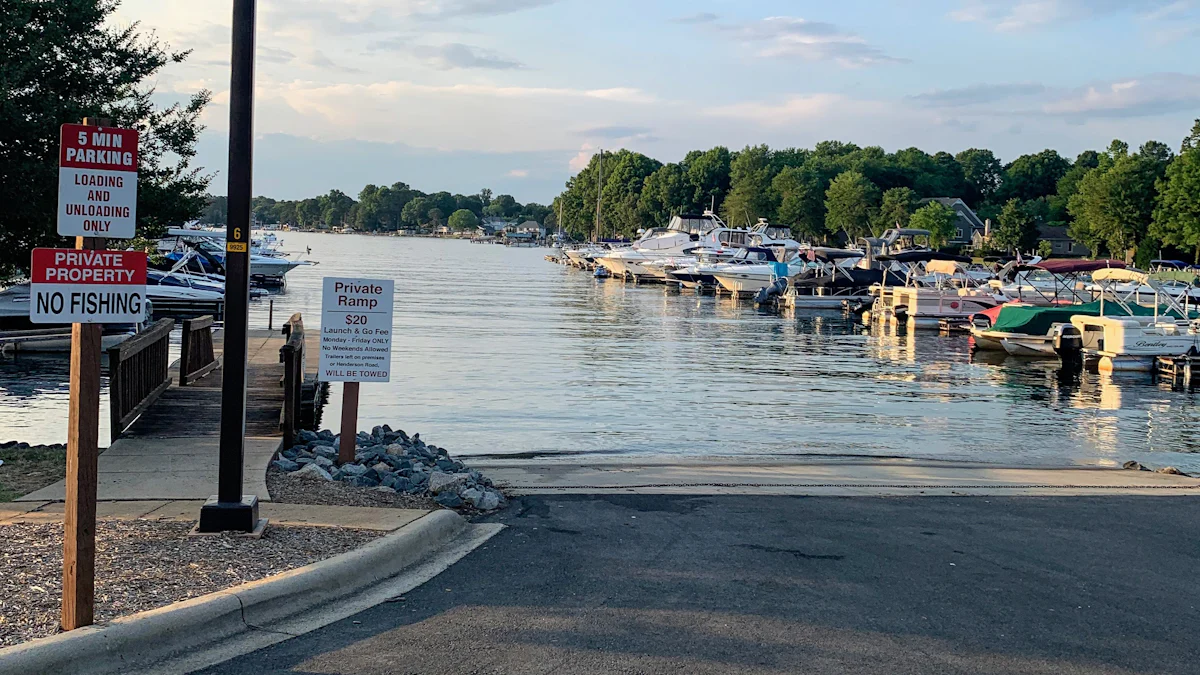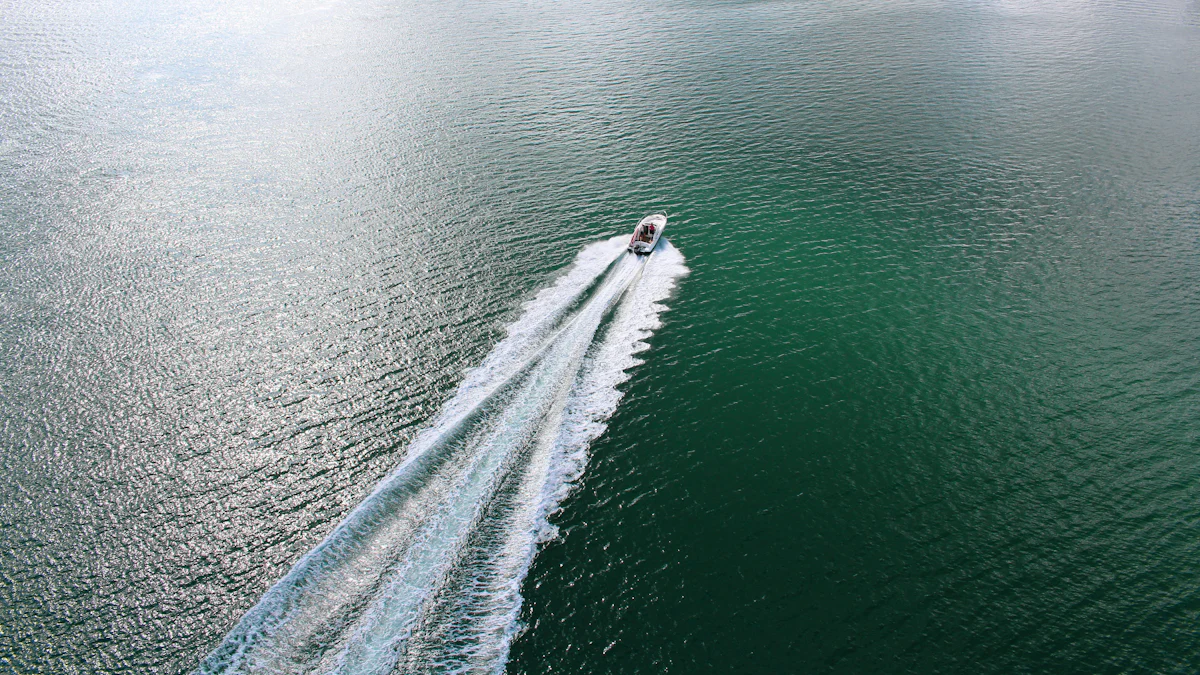Understanding boat ramp usage ensures safety and efficiency. Many recreational boating incidents occur due to improper handling at ramps. In 2023, the fatality rate reached *4.9 deaths per 100,000 registered vessels*. Proper knowledge reduces risks and enhances enjoyment. Safe practices protect lives and property. Efficient use of ramps saves time and prevents accidents. Mastering boat ramp skills benefits everyone on the water.
Preparation Before Arrival
Research and Planning
Checking local regulations and weather conditions
Research ensures a smooth boat ramp experience. Local regulations vary by location. Check these rules before heading out. Weather conditions affect safety. Monitor forecasts for wind and rain. Use reliable sources for accurate information. Plan your trip accordingly.
Selecting the right boat ramp
Choose the right boat ramp for your needs. Publicly available information helps in this process. Consider the type of launch and parking capacity. Driving directions guide you to the site. Inspect the launching area for debris. Ensure compliance with ramp rules and regulations.
Equipment and Gear Check
Ensuring all safety gear is on board
Safety gear is essential for every boat trip. The Boater’s Guide outlines federal requirements. Gear requirements depend on boat size and type. Check that all necessary equipment is on board. Life jackets, fire extinguishers, and flares are crucial. Regular checks prevent last-minute surprises.
Inspecting the boat and trailer
Inspect the boat and trailer thoroughly. Look for any signs of damage or wear. Ensure the trailer lights function properly. Secure the boat to the trailer before travel. Proper inspection prevents accidents on the road. A well-maintained boat enhances safety on water.
Arriving at the Boat Ramp

Parking and Unloading
Finding a suitable parking spot
Arriving at the boat ramp requires attention to parking. Look for a designated area to park your vehicle and trailer. A suitable spot ensures easy access to the ramp. Avoid blocking other boaters by parking within marked lines. Proper parking prevents congestion and maintains order.
Unloading equipment safely
Unload equipment carefully to avoid accidents. Place items on the dock or nearby staging area. Ensure gear remains secure and organized. Avoid rushing to prevent damage or injury. Safe unloading sets the stage for a smooth launch.
Preparing the Boat
Removing covers and securing items
Prepare the boat by removing covers. Secure loose items to prevent loss during launch. Check that all equipment is in place and ready for use. Proper preparation enhances safety and efficiency. A well-prepared boat ensures a successful outing.
Attaching lines and fenders
Attach lines and fenders to protect the boat. Lines help guide the boat during launch and docking. Fenders prevent damage from contact with the dock. Ensure lines are strong and securely fastened. Proper attachment safeguards the boat and dock.
A personal experience highlights the importance of preparation. An individual struggled with launching due to a mistake in the process. The person realized the error after multiple attempts. This story emphasizes the need for careful preparation and attention to detail.
Launching the Boat

Positioning and Backing Down
Aligning the trailer with the boat ramp
Align the trailer with the boat ramp to ensure a smooth launch. Position the vehicle so that the trailer is straight. Use side mirrors to check alignment frequently. A well-aligned trailer prevents accidents and mishaps. Boat ramp alignment is crucial for a successful launch.
Backing down slowly and steadily
Back down the boat ramp slowly and steadily. Maintain control of the vehicle at all times. Use low gear for better traction on the slope. Avoid sudden movements to prevent trailer sway. A steady approach ensures safety and precision.
Releasing and Securing
Releasing the boat from the trailer
Release the boat from the trailer carefully. Disconnect the winch strap before the boat enters the water. Use a single line attached to both the bow and stern cleat. This helps guide the boat off the trailer smoothly. Proper release techniques enhance safety and efficiency.
Securing the boat at the dock
Secure the boat at the dock immediately after launch. Attach lines to the dock cleats firmly. Ensure the boat remains stable and does not drift away. Check that fenders protect the boat from contact with the dock. Securing the boat prevents damage and ensures peace of mind.
Expert Testimony:
BoatUS Expert advises, “Before you even think about backing down the ramp, take 10 minutes in the staging area to load all the gear into the boat, attach lines to the bow and stern cleats, check that the plug is in, remove the rear tie-downs, put the key in the ignition, and unplug the trailer lights.”
Following these steps ensures a safe and efficient experience at the boat ramp. Mastering these skills enhances enjoyment and safety on the water.
Post-Launch Considerations
Parking the Trailer
Finding a designated trailer parking area
Locate a designated trailer parking area after launching the boat. Many boat ramps provide specific zones for trailer parking. Use these areas to avoid congestion and ensure safety. Proper parking of the trailer prevents obstruction for others. A well-organized parking area enhances efficiency at the ramp.
Securing the trailer properly
Secure the trailer properly to prevent movement. Use wheel chocks to stabilize the trailer on uneven surfaces. Ensure the trailer hitch is locked to deter theft. Regular checks of the trailer’s security maintain peace of mind. Properly secured trailers contribute to a safe boating environment.
Safety Checks on Water
Conducting a final safety check
Conduct a final safety check before venturing further into the water. Verify that all safety gear is accessible and functional. Check communication devices for signal strength and battery life. Ensure everyone on board understands safety protocols. A comprehensive safety check reduces risks while boating.
Reviewing navigation plans
Review navigation plans to ensure a smooth journey. Confirm the route using updated maps or GPS devices. Identify potential hazards such as shallow waters or restricted zones. Share the navigation plan with all passengers for awareness. Clear navigation plans enhance safety and enjoyment on the water.
Multiple Boaters shared insights from a boating safety course. The course provided valuable information on safety checks and navigation planning. Many participants found the educational content beneficial for enhancing their boating skills.
Additional Resources and Recommendations
Product Recommendations
Safety gear and equipment
Boating safety requires essential gear. Boating Safety Equipment List offers a comprehensive guide. Every person on board needs a Personal Flotation Device (PFD). Children under 12 must wear PFDs on moving vessels. Personal watercraft riders also need PFDs at all times. Fire extinguishers are crucial for emergencies. Boats under 26 feet require at least one B-1 type extinguisher. Larger boats need two B-1 types or one B-2 type. Discuss extinguisher use with family and guests. Pull the pin, squeeze the handle, and aim at the base of flames. Pets should also have lifejackets for safety.
Maintenance tools and supplies
Proper maintenance keeps boats in top condition. Regular checks prevent unexpected issues. Boat Safety Checklist & Safety Equipment provides useful insights. Inspect the hull for cracks or damage. Clean the boat regularly to prevent algae buildup. Check the engine oil and fuel levels before each trip. Ensure the battery is charged and functioning. Keep spare parts and tools on board for emergencies. A well-maintained boat enhances safety and performance.
Related Blogs and Articles
Tips for first-time boaters
First-time boaters benefit from expert advice. Understanding basic boating skills ensures safety. Learn about navigation rules and signals. Practice docking and launching techniques. Familiarize yourself with local waterway regulations. Consider taking a boating safety course. Courses provide valuable knowledge and confidence. Experienced boaters share insights and tips. Reading related blogs enhances your boating experience.
Best practices for boat maintenance
Regular maintenance extends the life of your boat. Follow best practices for optimal performance. Schedule routine inspections and servicing. Pay attention to the engine and electrical systems. Clean and wax the boat to protect the exterior. Store the boat properly during off-season months. Use quality products for cleaning and repairs. Keeping up with maintenance ensures a safe and enjoyable boating experience.
Mastering the essential steps for safe boat ramp use ensures a smooth and enjoyable boating experience. Practicing safety and preparation builds confidence and enhances skills. Many boaters, like Boater 1, find that thorough preparation leads to a more enjoyable time on the water. Boater 2 emphasizes the importance of following boating rules to stay safe. Explore additional resources and products to further enhance your boating knowledge. These tools provide valuable insights and support for both new and experienced boaters. Embrace safe boating practices to create a fun and secure environment for everyone.









